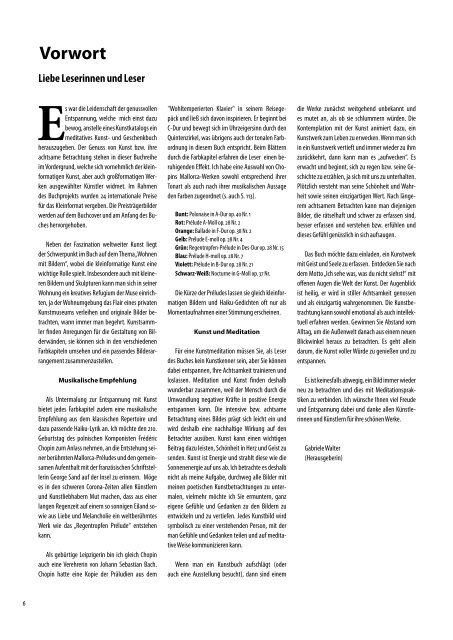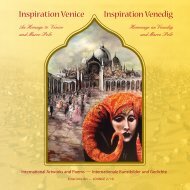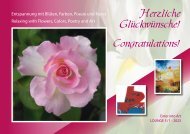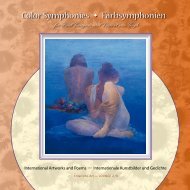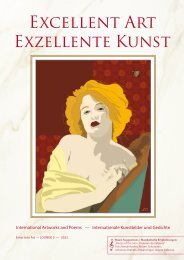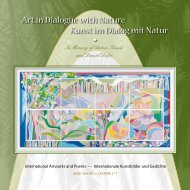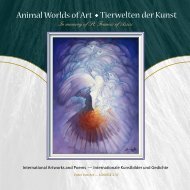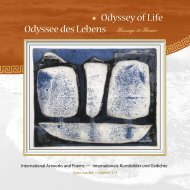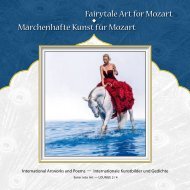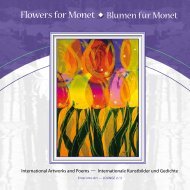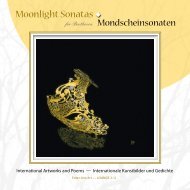Art Retreat - Living with Pictures, 2020-21, vol. 6
Fascination of worldwide art, color and meditation Small-format pictures from all over the world are not only suitable for an affordable as well as exotic art collection, but also for creating inspired refuges in living spaces. On the occasion of the 6th international “Enter into Art” art competition for the promotion of small-format pictures the art book shows - in addition to exquisite large-format pictures - over 150 works by artists from 36 Countries and 5 continents. At the same time it is a poetry book for relaxation with art, poetry and colors. The pictures are arranged in color chapters for careful viewing and relaxation. One chapter of the book is dedicated to the 210th anniversary of birth of the Polish composer Frédéric Chopin. During his stay with the French writer George Sand on the island of Mallorca, he wrote the world-famous "Rainbow Prelude". Chopin's dreamy Mallorca pieces flow into the creative contemplation of the pictures as musical recommendations. The printed book is available in the book trade and in internet bookshops. Softcover: ISBN 978-3-98527-215-0, Publisher: Re Di Roma-Verlag, Language: English, German, Size: 29 x 21 cm Or at Peecho (soft- and hardcover) by the following link: http://www.peecho.com/checkout/162187384649059167/1018526/art-retreat-living-with-pictures-2020-21-vol-6 Faszination weltweiter Kunst, Farbe und Meditation Kleinformatige Bilder aus aller Welt eignen sich nicht nur für eine sowohl erschwingliche als auch exotische Kunstsammlung, sondern auch für die Erschaffung musenvoller Refugien in Wohnräumen. Das Kunstbuch anlässlich des 6. Internationalen „Enter into Art“-Kunstwettbewerbes zur Förderung kleinformatiger Bilder zeigt – neben erlesenen großformatigen Bildern - über 150 Werke von Künstlern aus 36 Ländern und 5 Kontinenten. Gleichzeitig ist es ein Poesiebuch zur Entspannung mit Kunst, Lyrik und Farben. Die Bilder sind in Farbkapiteln zum achtsamen Betrachten und Entspannen arrangiert. Ein Kapitel des Buches ist dem 210. Geburtstag des polnischen Komponisten Frédéric Chopin gewidmet. Während seines Aufenthaltes mit der französischen Schriftstellerin George Sand auf der Insel Mallorca schrieb er das weltberühmte „Regenbogen-Prélude“. Chopins verträumte Mallorca-Stücke fließen als musikalische Empfehlungen in die musenvolle Betrachtung der Bilder ein.
Fascination of worldwide art, color and meditation
Small-format pictures from all over the world are not only suitable for an affordable as well as exotic art collection, but also for creating inspired refuges in living spaces. On the occasion of the 6th international “Enter into Art” art competition for the promotion of small-format pictures the art book shows - in addition to exquisite large-format pictures - over 150 works by artists from 36 Countries and 5 continents. At the same time it is a poetry book for relaxation with art, poetry and colors. The pictures are arranged in color chapters for careful viewing and relaxation. One chapter of the book is dedicated to the 210th anniversary of birth of the Polish composer Frédéric Chopin. During his stay with the French writer George Sand on the island of Mallorca, he wrote the world-famous "Rainbow Prelude". Chopin's dreamy Mallorca pieces flow into the creative contemplation of the pictures as musical recommendations.
The printed book is available in the book trade and in internet bookshops. Softcover: ISBN 978-3-98527-215-0, Publisher: Re Di Roma-Verlag, Language: English, German, Size: 29 x 21 cm
Or at Peecho (soft- and hardcover) by the following link:
http://www.peecho.com/checkout/162187384649059167/1018526/art-retreat-living-with-pictures-2020-21-vol-6
Faszination weltweiter Kunst, Farbe und Meditation
Kleinformatige Bilder aus aller Welt eignen sich nicht nur für eine sowohl erschwingliche als auch exotische Kunstsammlung, sondern auch für die Erschaffung musenvoller Refugien in Wohnräumen. Das Kunstbuch anlässlich des 6. Internationalen „Enter into Art“-Kunstwettbewerbes zur Förderung kleinformatiger Bilder zeigt – neben erlesenen großformatigen Bildern - über 150 Werke von Künstlern aus 36 Ländern und 5 Kontinenten. Gleichzeitig ist es ein Poesiebuch zur Entspannung mit Kunst, Lyrik und Farben. Die Bilder sind in Farbkapiteln zum achtsamen Betrachten und Entspannen arrangiert. Ein Kapitel des Buches ist dem 210. Geburtstag des polnischen Komponisten Frédéric Chopin gewidmet. Während seines Aufenthaltes mit der französischen Schriftstellerin George Sand auf der Insel Mallorca schrieb er das weltberühmte „Regenbogen-Prélude“. Chopins verträumte Mallorca-Stücke fließen als musikalische Empfehlungen in die musenvolle Betrachtung der Bilder ein.
Create successful ePaper yourself
Turn your PDF publications into a flip-book with our unique Google optimized e-Paper software.
Vorwort<br />
Foreword<br />
Liebe Leserinnen und Leser<br />
Dear reader<br />
Es war die Leidenschaft der genuss<strong>vol</strong>len<br />
Entspannung, welche mich einst dazu<br />
bewog, anstelle eines Kunstkatalogs ein<br />
meditatives Kunst- und Geschenkbuch<br />
herauszugeben. Der Genuss von Kunst bzw. ihre<br />
achtsame Betrachtung stehen in dieser Buchreihe<br />
im Vordergrund, welche sich vornehmlich der kleinformatigen<br />
Kunst, aber auch großformatigen Werken<br />
ausgewählter Künstler widmet. Im Rahmen<br />
des Buchprojekts wurden 24 internationale Preise<br />
für das Kleinformat vergeben. Die Preisträgerbilder<br />
werden auf dem Buchcover und am Anfang des Buches<br />
hervorgehoben.<br />
Neben der Faszination weltweiter Kunst liegt<br />
der Schwerpunkt im Buch auf dem Thema „Wohnen<br />
mit Bildern“, wobei die kleinformatige Kunst eine<br />
wichtige Rolle spielt. Insbesondere auch mit kleineren<br />
Bildern und Skulpturen kann man sich in seiner<br />
Wohnung ein kreatives Refugium der Muse einrichten,<br />
ja der Wohnumgebung das Flair eines privaten<br />
Kunstmuseums verleihen und originale Bilder betrachten,<br />
wann immer man begehrt. Kunstsammler<br />
finden Anregungen für die Gestaltung von Bilderwänden,<br />
sie können sich in den verschiedenen<br />
Farbkapiteln umsehen und ein passendes Bilderarrangement<br />
zusammenzustellen.<br />
Musikalische Empfehlung<br />
Als Untermalung zur Entspannung mit Kunst<br />
bietet jedes Farbkapitel zudem eine musikalische<br />
Empfehlung aus dem klassischen Repertoire und<br />
dazu passende Haiku-Lyrik an. Ich möchte den <strong>21</strong>0.<br />
Geburtstag des polnischen Komponisten Frédéric<br />
Chopin zum Anlass nehmen, an die Entstehung seiner<br />
berühmten Mallorca-Préludes und den gemeinsamen<br />
Aufenthalt mit der französischen Schriftstellerin<br />
George Sand auf der Insel zu erinnern. Möge<br />
es in den schweren Corona-Zeiten allen Künstlern<br />
und Kunstliebhabern Mut machen, dass aus einer<br />
langen Regenzeit auf einem so sonnigen Eiland sowie<br />
aus Liebe und Melancholie ein weltberühmtes<br />
Werk wie das „Regentropfen Prélude“ entstehen<br />
kann.<br />
Als gebürtige Leipzigerin bin ich gleich Chopin<br />
auch eine Verehrerin von Johann Sebastian Bach.<br />
Chopin hatte eine Kopie der Präludien aus dem<br />
"Wohltemperierten Klavier" in seinem Reisegepäck<br />
und ließ sich davon inspirieren. Er beginnt bei<br />
C-Dur und bewegt sich im Uhrzeigersinn durch den<br />
Quintenzirkel, was übrigens auch der tonalen Farbordnung<br />
in diesem Buch entspricht. Beim Blättern<br />
durch die Farbkapitel erfahren die Leser einen beruhigenden<br />
Effekt. Ich habe eine Auswahl von Chopins<br />
Mallorca-Werken sowohl entsprechend ihrer<br />
Tonart als auch nach ihrer musikalischen Aussage<br />
den Farben zugeordnet (s. auch S. 113).<br />
Bunt: Polonaise in A-Dur op. 40 Nr. 1<br />
Rot: Prélude A-Moll op. 28 Nr. 2<br />
Orange: Ballade in F-Dur op. 38 Nr. 2<br />
Gelb: Prélude E-moll op. 28 Nr. 4<br />
Grün: Regentropfen-Prélude in Des-Dur op. 28 Nr. 15<br />
Blau: Prélude H-moll op. 28 Nr. 7<br />
Violett: Prélude in B-Dur op. 28 Nr. <strong>21</strong><br />
Schwarz-Weiß: Nocturne in G-Moll op. 37 Nr.<br />
Die Kürze der Préludes lassen sie gleich kleinformatigen<br />
Bildern und Haiku-Gedichten oft nur als<br />
Momentaufnahmen einer Stimmung erscheinen.<br />
Kunst und Meditation<br />
Für eine Kunstmeditation müssen Sie, als Leser<br />
des Buches kein Kunstkenner sein, aber Sie können<br />
dabei entspannen, Ihre Achtsamkeit trainieren und<br />
loslassen. Meditation und Kunst finden deshalb<br />
wunderbar zusammen, weil der Mensch durch die<br />
Umwandlung negativer Kräfte in positive Energie<br />
entspannen kann. Die intensive bzw. achtsame<br />
Betrachtung eines Bildes prägt sich leicht ein und<br />
wird deshalb eine nachhaltige Wirkung auf den<br />
Betrachter ausüben. Kunst kann einen wichtigen<br />
Beitrag dazu leisten, Schönheit in Herz und Geist zu<br />
senden. Kunst ist Energie und strahlt diese wie die<br />
Sonnenenergie auf uns ab. Ich betrachte es deshalb<br />
nicht als meine Aufgabe, durchweg alle Bilder mit<br />
meinen poetischen Kunstbetrachtungen zu untermalen,<br />
vielmehr möchte ich Sie ermuntern, ganz<br />
eigene Gefühle und Gedanken zu den Bildern zu<br />
entwickeln und zu vertiefen. Jedes Kunstbild wird<br />
symbolisch zu einer verstehenden Person, mit der<br />
man Gefühle und Gedanken teilen und auf meditative<br />
Weise kommunizieren kann.<br />
Wenn man ein Kunstbuch aufschlägt (oder<br />
auch eine Ausstellung besucht), dann sind einem<br />
die Werke zunächst weitgehend unbekannt und<br />
es mutet an, als ob sie schlummern würden. Die<br />
Kontemplation mit der Kunst animiert dazu, ein<br />
Kunstwerk zum Leben zu erwecken. Wenn man sich<br />
in ein Kunstwerk vertieft und immer wieder zu ihm<br />
zurückkehrt, dann kann man es „aufwecken“. Es<br />
erwacht und beginnt, sich zu regen bzw. seine Geschichte<br />
zu erzählen, ja sich mit uns zu unterhalten.<br />
Plötzlich versteht man seine Schönheit und Wahrheit<br />
sowie seinen einzigartigen Wert. Nach längerem<br />
achtsamem Betrachten kann man diejenigen<br />
Bilder, die rätselhaft und schwer zu erfassen sind,<br />
besser erfassen und verstehen bzw. erfühlen und<br />
dieses Gefühl genüsslich in sich aufsaugen.<br />
Das Buch möchte dazu einladen, ein Kunstwerk<br />
mit Geist und Seele zu erfassen. Entdecken Sie nach<br />
dem Motto „Ich sehe was, was du nicht siehst!“ mit<br />
offenen Augen die Welt der Kunst. Der Augenblick<br />
ist heilig, er wird in stiller Achtsamkeit genossen<br />
und als einzigartig wahrgenommen. Die Kunstbetrachtung<br />
kann sowohl emotional als auch intellektuell<br />
erfahren werden. Gewinnen Sie Abstand vom<br />
Alltag, um die Außenwelt danach aus einem neuen<br />
Blickwinkel heraus zu betrachten. Es geht allein<br />
darum, die Kunst <strong>vol</strong>ler Würde zu genießen und zu<br />
entspannen.<br />
Es ist keinesfalls abwegig, ein Bild immer wieder<br />
neu zu betrachten und dies mit Meditationspraktiken<br />
zu verbinden. Ich wünsche Ihnen viel Freude<br />
und Entspannung dabei und danke allen Künstlerinnen<br />
und Künstlern für ihre schönen Werke.<br />
Gabriele Walter<br />
(Herausgeberin)<br />
It was the passion for pleasurable relaxation<br />
that once moved me to publish a meditative<br />
art and gift book instead of an art catalog.<br />
The enjoyment of art and its mindful contemplation<br />
are in the foreground in this series of<br />
books, which is primarily dedicated to small-format<br />
art, but also to large-format works by selected artists.<br />
As part of the book project, 24 international<br />
prizes were awarded for the small-format artworks.<br />
The award-winning images will be highlighted on<br />
the book cover and at the beginning of the book.<br />
In a addition to the fascination of art worldwide,<br />
the focus of the book is on the subject of "<strong>Living</strong><br />
<strong>with</strong> <strong>Pictures</strong>", <strong>with</strong> small-format art playing an<br />
important role. With smaller pictures and sculptures<br />
in particular, you can set up a creative retreat for<br />
contemplation in your living space, lend the home<br />
environment the elegant style of a private art museum<br />
and look at original pictures whenever you<br />
want. <strong>Art</strong> collectors find ideas for the design of picture<br />
walls, they can browse in the various chapters<br />
on color, and put together a suitable arrangement<br />
of pictures.<br />
Music suggestion<br />
As an accompaniment to relaxation through art,<br />
each color chapter also offers a musical recommendation<br />
from the classical repertoire and matching<br />
haiku poetry. I would like to use the <strong>21</strong>0th birthday<br />
of the Polish composer Frédéric Chopin as an opportunity<br />
to remember the creation of his famous<br />
Majorca Preludes and the time he stayed on the island<br />
together <strong>with</strong> the French writer George Sand.<br />
May it encourage all artists and art lovers in these<br />
difficult Corona times that a world-famous work<br />
like the "Raindrop Prelude" can emerge from a long<br />
rainy season on such a sunny island as well as from<br />
love and melancholy.<br />
Born in Leipzig, I am, like Chopin, also an admirer<br />
of Johann Sebastian Bach. Chopin had a copy of<br />
the preludes from the "Well-Tempered Piano" in<br />
his luggage and was inspired by it. It starts <strong>with</strong> C<br />
major and moves clockwise through the circle of<br />
fifths, which basically corresponds to the tonal order<br />
of colors in this book. When leafing through the<br />
color chapters, readers experience a relaxing effect.<br />
I have assigned a selection of Chopin's Majorca Preludes<br />
to the colors, both according to their key and<br />
according to their musical statement (s. also p. 113).<br />
Multicolored: Polonaise in A Major op. 40 No. 1<br />
Red: Prélude in A Minor op. 28 No. 2<br />
Orange: Ballade in F Major op. 38 No. 2<br />
Yellow: Prélude in E Minor op. 28 No. 4<br />
Green: "Raindrop Prélude" in D Flat Major op. 28 No. 15<br />
Blue: Prélude in B Minor op. 28 No. 7<br />
Violet: Prélude in B Flat Major op. 28 No. <strong>21</strong><br />
Black-White: Nocturne in G Minor op. 37 No. 1<br />
The shortness of the Préludes allows small-format<br />
paintings and haiku poems equally to appear<br />
often only as snapshots of a mood.<br />
<strong>Art</strong> and meditation<br />
As a reader of the book, you do not have to be<br />
an art connoisseur for an art meditation, but you<br />
can relax, train your attention and let go. Therefore,<br />
meditation and art come together wonderfully,<br />
because one can relax through the conversion of<br />
negative forces into positive energy. The intensive<br />
or mindful contemplation of a picture is easy to<br />
remember and will therefore have a lasting effect<br />
on the viewer. <strong>Art</strong> can make an important contribution<br />
to sending beauty into the heart and mind.<br />
<strong>Art</strong> is energy and radiates it on us like solar energy.<br />
I therefore do not see it as my task to accompany all<br />
of the pictures <strong>with</strong> my poetic interpretation of art,<br />
rather I would like to encourage you to develop and<br />
deepen your own feelings and thoughts about the<br />
pictures. Every artwork symbolically becomes an<br />
understanding individual <strong>with</strong> whom one can share<br />
feelings and thoughts and communicate in a meditative<br />
way.<br />
When you open an art book (or visit an exhibition),<br />
the works are initially largely unknown and it<br />
seems as if they are sleeping. Contemplation <strong>with</strong><br />
art encourages you to bring a work of art to life. If<br />
you immerse yourself in a work of art and keep coming<br />
back to it, then you can “wake it up”. It wakes<br />
up and begins to bestir or to tell its story, even to<br />
talk to us. Suddenly one understands its beauty and<br />
truth as well as its unique worth. After prolonged<br />
mindful consideration one can better detect those<br />
images that are enigmatic and difficult to understand,<br />
better grasp and understand or feel their<br />
spirit and soak up this feeling <strong>with</strong> relish.<br />
The book would like to invite you to grasp a work<br />
of art <strong>with</strong> mind and soul. Discover the world of art<br />
<strong>with</strong> open eyes according to the motto “I see what<br />
you don't see!”. The moment is sacred, it is enjoyed<br />
in quiet mindfulness and perceived as unique. Viewing<br />
art can be experienced both emotionally and<br />
intellectually. Gain distance from everyday life in<br />
order to see the outside world from a new perspective.<br />
It’s all about enjoying the art <strong>with</strong> dignity and<br />
relaxing.<br />
It is by no means absurd to look at a picture over<br />
and over again and to merge this <strong>with</strong> meditative<br />
practices. I wish you much joy and relaxation while<br />
looking at the artworks and thank the artists for<br />
their beautiful works.<br />
Gabriele Walter<br />
(editor)<br />
Note for translation:<br />
Feel free to use “Google Translate” to help you read<br />
our posts in your language. Some texts of the book<br />
may be available for your own translation on the Internet.<br />
You can visit our websites:<br />
www.enterintoart.com<br />
www.enter-into-art.com<br />
6 7


